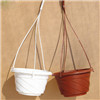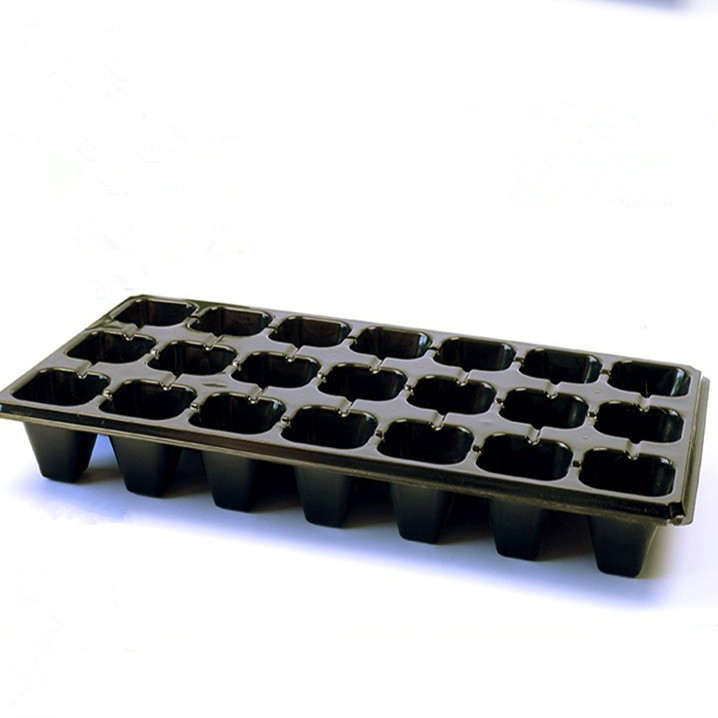Choose an appropriate plug tray, select a good substrate, fill the substrate correctly, punch holes, sow the seeds evenly into the center of the hole, cover the seeds evenly, and water appropriately. This completes the first step of factory plug seedling cultivation.
The choice of plug tray:
The matrix must have a depth of at least 5mm to have the effect of gravity, so that the moisture in the matrix can penetrate, and the deeper the air enters the pores, the more oxygen will be contained. The shape of the hole is preferably a square inverted trapezoid, which is beneficial to guide the root system to extend downward, rather than the root system being entangled on the inner wall as in a circular or vertical hole. Deeper holes provide more favorable conditions for the drainage and ventilation of the matrix.
Some plug trays have ventilation holes between the holes so that air can flow between plants. Make the leaves dry, reduce disease, dry evenly, and ensure that the whole plant grows evenly.
The color of the plug also affects the root temperature of the plant. Generally, black plug trays are chosen in winter and spring because they can absorb more solar energy and increase the root temperature. In summer or early autumn, it is necessary to change to silver-gray plug trays to reflect more light and avoid excessive root temperature. White plugs generally have higher light transmittance, which will affect root growth, so white plugs are rarely chosen. Of course, the white foam tray can be an exception.
Plug trays that have been thoroughly cleaned and disinfected can also be reused. It is recommended to use safer quaternary ammonium salt disinfectants. They can also be used to sterilize and remove algae in the irrigation system to avoid the growth of bacteria and moss. It is not recommended to use bleach or chlorine for disinfection, because chlorine will chemically react with the plastic in the plug tray to produce toxic substances.
Matrix selection and correct filling
Choice of substrate:
A good matrix should have the following characteristics: ideal water capacity; good drainage and air capacity; easy to rewet; good porosity and uniform void distribution; stable vascular bundle structure with less dust; appropriate pH value , 5.5-6.5; Contains appropriate nutrients to ensure the nutrient requirements of the cotyledons before expansion; extremely low salt level, EC is less than 0.7 (1:2 dilution method); the size of the substrate particles is uniform; no plant diseases, insect pests and weeds ; The quality of each batch of matrix remains the same.
The effect of vermiculite with smaller particles is to increase the water retention capacity of the matrix instead of porosity. To increase the drainage and air permeability of the peat matrix, choose to add perlite instead of vermiculite. On the contrary, if you want to increase the water holding capacity, you can add a certain amount of small particles of vermiculite.
Note the following:
1. The matrix should be fully moistened before filling, generally 60% is appropriate, hold the matrix with your hand, no water will be squeezed out, loose your hand will form a clump, but lightly touch, the matrix will disperse. If it is too dry, the substrate will collapse after watering in the future, resulting in poor ventilation and poor root development.
2. The filling degree of each hole should be uniform, otherwise the hole with less base mass will dry faster, which will make the moisture management uneven;
3. The hole matrix for sowing large seeds such as melons should not be too full;
4. Avoid squeezing the substrate, otherwise it will affect the air permeability and drying speed of the substrate, and because the substrate is too tight, the seeds will rebound, resulting in different depths when the seeds germinate.
Punch and sow
Note: The depth of the holes must be consistent to ensure that the depth of the seeding is also consistent. Generally, the larger the seed, the deeper the sowing depth.
Even coverage
Several common vegetable seeds need to germinate smoothly under dark conditions, so it is also important to choose the right mulch. The choice of covering should consider several aspects: it can increase the humidity around the seeds and maintain good air permeability to provide enough oxygen for the seeds. It is recommended to use large particles of vermiculite as a covering. The perlite cover is easy to breed moss.
Watering for the first time after sowing
Two options: when the seeds germinate on the seedbed, a small amount of water should be poured first, and after all the plugs are moved to the seedbed, the seeds should be watered again. If the seeds are in a germination room or a simple germination space (after the grass thatch is covered and moisturized), water thoroughly before entering the germination room. It is recommended to use an atomized nozzle or a nozzle with fine water spray.














